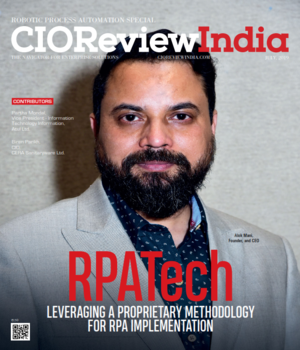
Optimising Test Instrumentation with Robotic Process Automation
Ankit Jain, IT Head, WIKA India
 Ankit, a seasoned IT professional with 15+ years' expertise, specializes in IT rollouts encompassing infrastructure and applications. He drives strategic alignment, standardization, and automation of business requirements and processes.
Ankit, a seasoned IT professional with 15+ years' expertise, specializes in IT rollouts encompassing infrastructure and applications. He drives strategic alignment, standardization, and automation of business requirements and processes.
In the phase of the industrial revolution that we are in, the industry demands seamless productivity, agile processes, and zero errors. Thus, a robust test and measurement ecosystem becomes imperative to achieve these paraments. Research and Development of a component is a time-consuming process where manufacturers need to test every intricate detail of every process. Even the slightest change in the smallest component requires the testing of the entire process all over again. Although, testing is an essential component in every phase of product development, repeating and achieving the required parameters and getting it manually verified is a time-consuming and labour-intensive process.
This is where Robotic Process Automation (RPA) comes into the picture to ramp up the process while giving optimum accuracy and perfection to the process analysis. In a nutshell, RPA draws out the robot from the human and performs arduous, repetitive tasks quickly, accurately and tirelessly, leaving humans to be productive in other areas.
This dynamic tool is expected to witness a huge surge in the industry. According to Fortune Business Insights’ report, the global robotic process automation market is projected to grow at a CAGR of 20.3%, from $13.86 billion in 2023 to become a $50.50 billion market by 2030.
Understanding RPA
Robotic process automation is a software robotics that uses intelligent automation technologies that mimic the way humans interact with software to perform high-volume, repetitive tasks. The RPA technology creates bots that can crawl into applications, enter data, calculate and complete tasks just like humans.
RPA combines Application Programming Interface (API) and User Interface (UI) interactions to perform repetitive tasks. By deploying scripts that emulate human processes, RPA tools can autonomously execute various activities across numerous software systems.
In a manufacturing setup, designing, testing and verifying the accuracy of each product is time-consuming, repetitive and costly. Each component needs to be tested in various environments, s implying that each step requires numerous, repeated testing and verifications. Here, RPA software can take over the repetitive tasks involved in testing, such as clicking on software or swapping out test instruments. This allows R&D engineers to optimize their time by working on other aspects of the projects.
The Dynamics of RPA
Testing a design goes through numerous steps. Since various components are tested under a range of simulated real-world environments and conditions, engineers need to verify and re-verify the accuracy and seamless performance of the components. Furthermore, each of these measurements is conducted in a configured environment, and the steps are repeated in each environmental scenario wherein the engineers need to change the test instruments, probes, and hardware and adjust settings throughout the process.
Also, since every test environment is different, there are multiple test instruments required at every step. At times, components do not support the software or instrumentation which further leads to delays in instrumentation switching or getting new instrumentation that is compatible with the process. All this leads to further loss of time which eventually increases the cost of the overall operation.
Hastening the work by cutting corners in verification is not an option as it might lead to a catastrophe. Thus, completing the task with efficiency is the key.
Here, RPA can be incorporated to constantly assess and verify the test results on a real-time basis. It also ascertains the debugging of hardware to ensure that components perform optimally under various conditions and instantly records the anomalies in any situation. RPA not only conducts repetitive tests but also changes the instrumentation measurement parameters, switches between software applications to take different measurements, and integrates compatible instrumentation when required. This saves a huge amount of time and releases engineers from these repetitive processes. It further eliminates human errors and thus entails a huge cost saving as well.
The Future Testing with RPA
The integration of RPA has increased the overall efficiency of testing tasks. This level of automation also enables engineers to shift focus from repetitive tasks to more important tasks and be more productive to give better performance in the overall realm of the project. This also enables engineers to work on multiple projects with equal efficiency.
RPA shoulders the quality of test instruments environment by providing accuracy, improving productivity and making way for innovation by enhancing the performance of the R&D engineers. RPA is undoubtedly the future for accentuating precision and perfection in every measurement.
CIO Viewpoint
Upcoming Technological Advancements in Payments...
By Pinak Chakraborty, CIO of Airtel Payments Bank
Shaping the Future of AI: Talent, Innovation,...
By Yann LeCun, Chief AI Scientist at Meta
Future of Smart Manufacturing: Integrating Tech...
By Mohammed Kaishulla, Chief information officer, EPACK Durable
CXO Insights
How RPA is Revolutionizing the Manufacturing...
By Rajeev Soota, VP-IT, Usha International
Optimising Test Instrumentation with Robotic...









